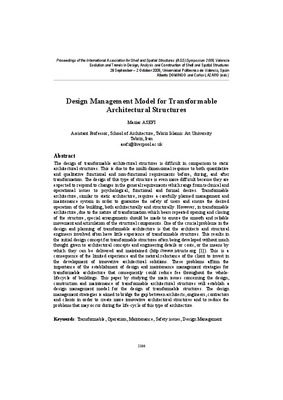JavaScript is disabled for your browser. Some features of this site may not work without it.
Buscar en RiuNet
Listar
Mi cuenta
Estadísticas
Ayuda RiuNet
Admin. UPV
Design management model for transformable architectural structure
Mostrar el registro sencillo del ítem
Ficheros en el ítem
| dc.contributor.author | ASEFI, Maziar
|
|
| dc.contributor.editor | Domingo Cabo, Alberto
|
es_ES |
| dc.contributor.editor | Lázaro Fernández, Carlos Manuel
|
es_ES |
| dc.date.accessioned | 2010-02-24T11:05:39Z | |
| dc.date.available | 2010-02-24T11:05:39Z | |
| dc.date.issued | 2010-02-24T11:05:39Z | |
| dc.identifier.isbn | 978-84-8363-461-5 | |
| dc.identifier.uri | http://hdl.handle.net/10251/7283 | |
| dc.description | p. 2366-2379 | en_EN |
| dc.description.abstract | The design of transformable architectural structures is difficult in comparison to static architectural structures. This is due to the multi-dimensional response to both quantitative and qualitative functional and non-functional requirements before, during, and after transformation. The design of this type of structure is even more difficult because they are expected to respond to changes in the general requirements which range from technical and operational issues to psychological, functional and formal desires. Transformable architecture, similar to static architecture, requires a carefully planned management and maintenance system in order to guarantee the safety of users and ensure the desired operation of the building, both architecturally and structurally. However, in transformable architecture, due to the nature of transformation which bears repeated opening and closing of the structure, special arrangements should be made to ensure the smooth and reliable movement and articulation of the structural components. One of the crucial problems in the design and planning of transformable architecture is that the architects and structural engineers involved often have little experience of transformable structures. This results in the initial design concept for transformable structures often being developed without much thought given to architectural concepts and engineering details or costs, or the means by which they can be delivered and maintained (http://www.istructe.org [1]). This is a consequence of the limited experience and the natural reluctance of the client to invest in the development of innovative architectural solutions. These problems affirm the importance of the establishment of design and maintenance management strategies for transformable architecture that consequently could reduce fee throughout the wholelifecycle of buildings. This paper by studying the main issues concerning the design, construction and maintenance of transformable architectural structures will establish a design management model for the design of transformable structures. The design management strategies is aimed to bridge the gap between architects, engineers, contractors and clients in order to create more innovative architectural structures and to reduce the problems that may occur during the life-cycle of this type of architecture. | en_EN |
| dc.language | Inglés | en_EN |
| dc.publisher | Editorial Universitat Politècnica de València | es_ES |
| dc.relation.ispartof | Symposium of the International Association for Shell and Spatial Structures (50th. 2009. Valencia). Evolution and Trends in Design, Analysis and Construction of Shell and Spatial Structures : Proceedings | en_EN |
| dc.rights | Reserva de todos los derechos | en_EN |
| dc.subject | Transformable | en_EN |
| dc.subject | Operation | en_EN |
| dc.subject | Maintenance | en_EN |
| dc.subject | Safety issues | en_EN |
| dc.subject | Design management | en_EN |
| dc.title | Design management model for transformable architectural structure | en_EN |
| dc.type | Comunicación en congreso | en_EN |
| dc.rights.accessRights | Abierto | es_ES |
| dc.description.bibliographicCitation | Asefi, M. (2010). Design management model for transformable architectural structure. Editorial Universitat Politècnica de València. http://hdl.handle.net/10251/7283 | es_ES |
| dc.relation.conferencename | Symposium of the International Association for Shell and Spatial Structures | es_ES |
| dc.relation.conferencedate | 2009 | es_ES |
| dc.relation.conferenceplace | Valencia | es_ES |






